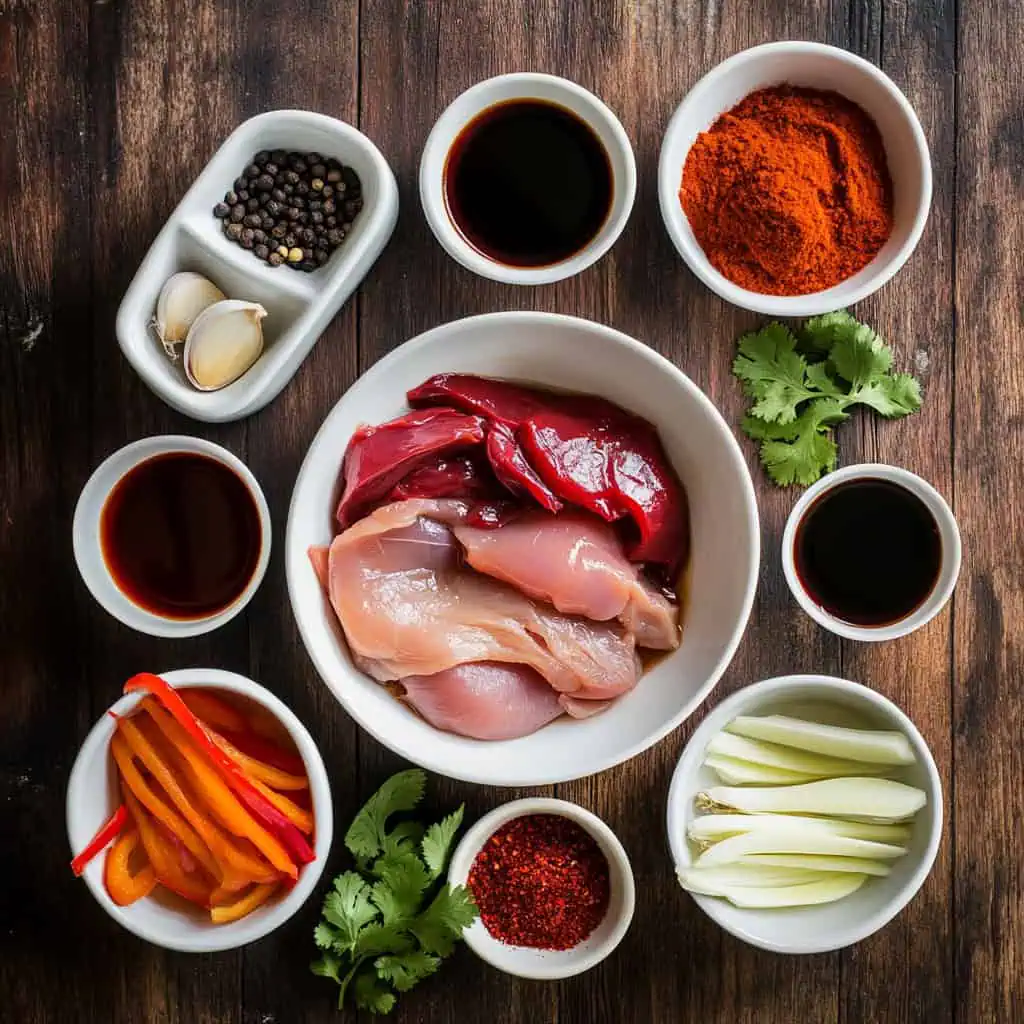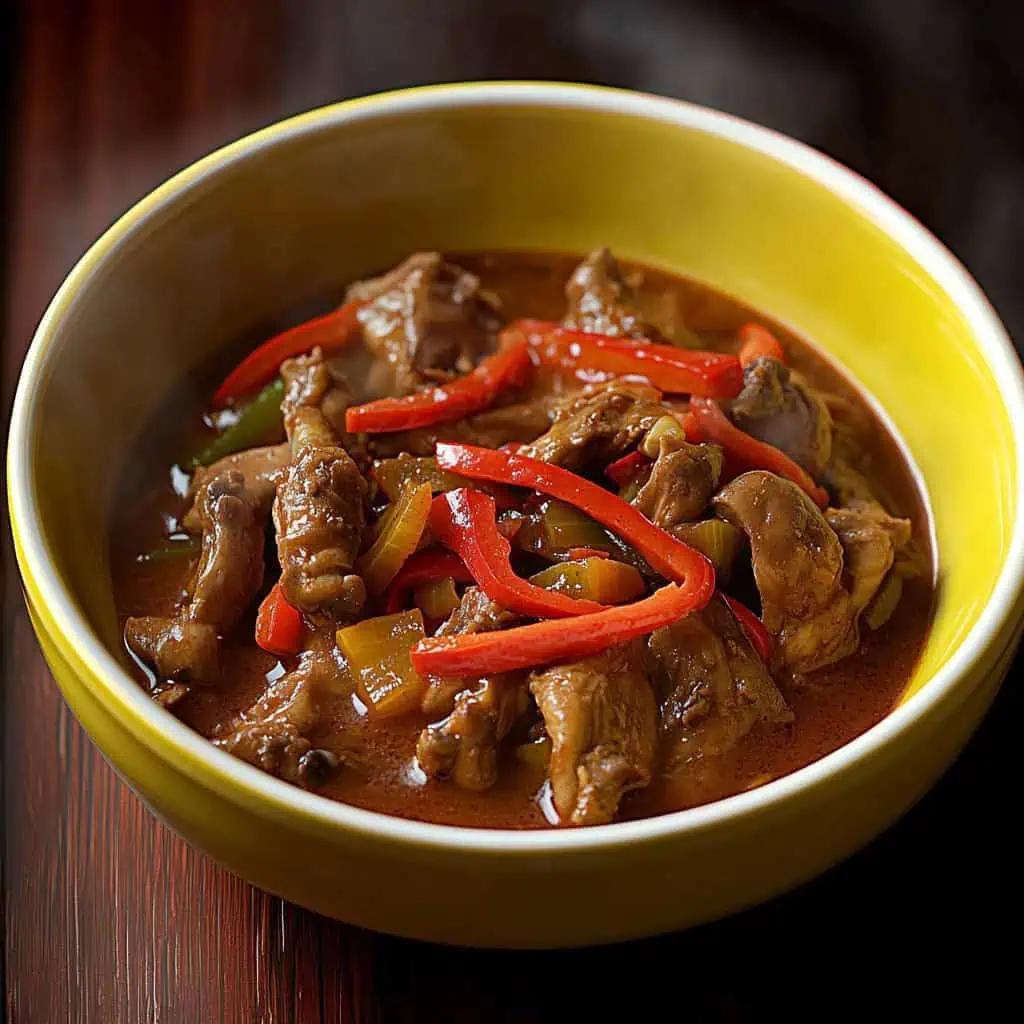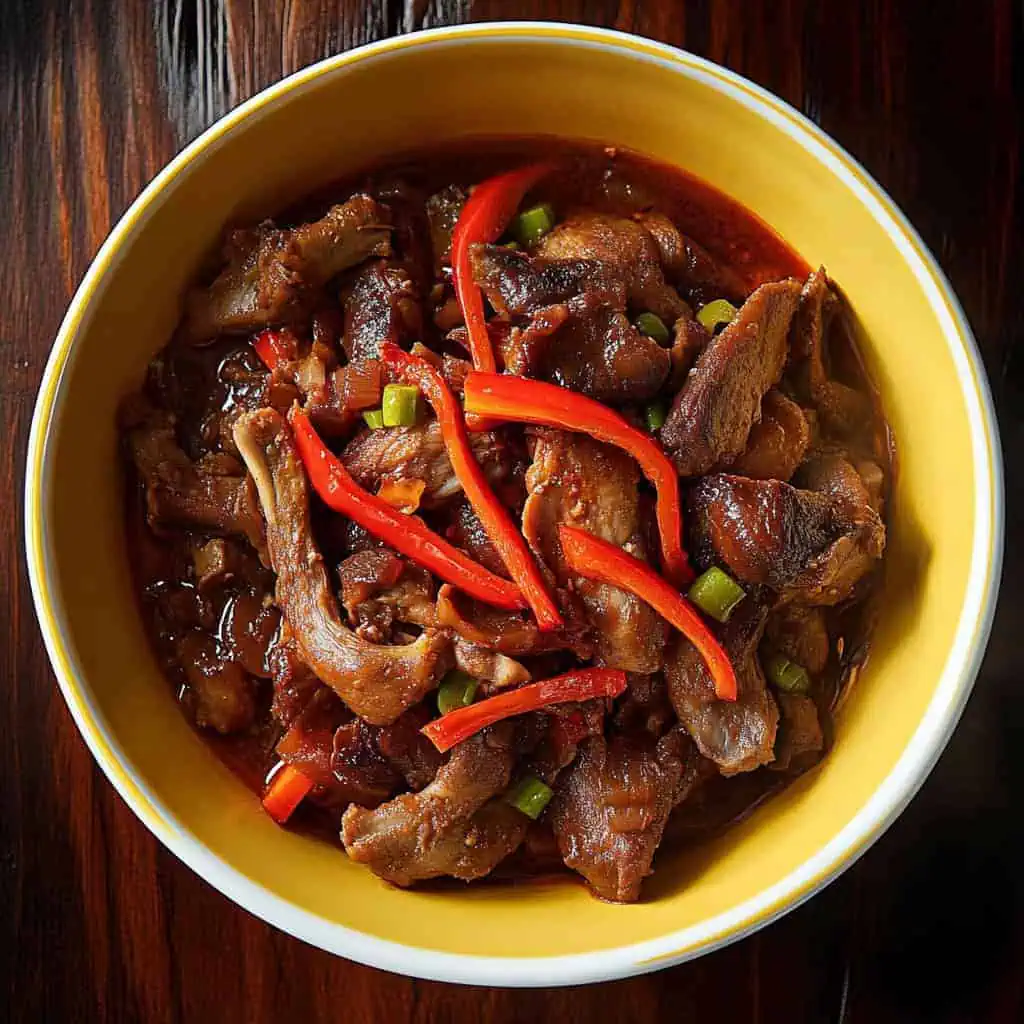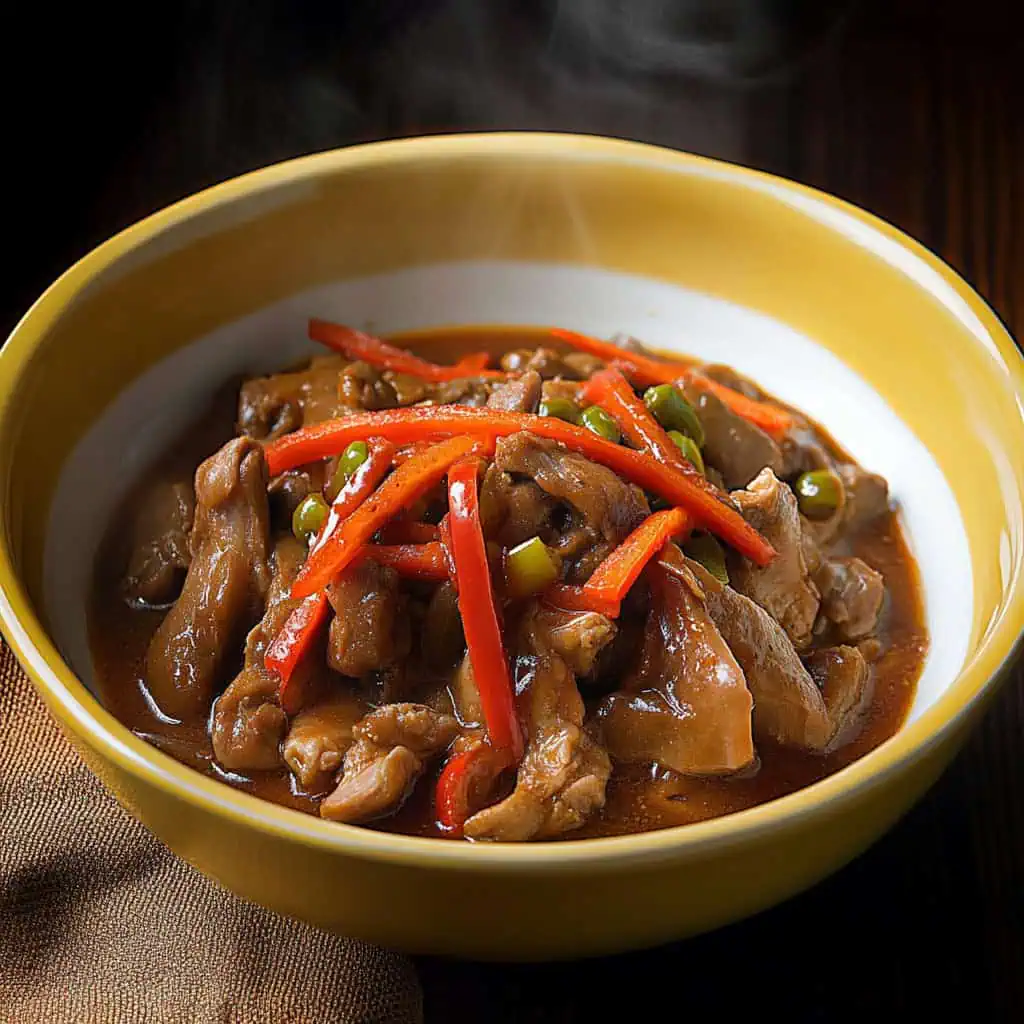I never thought chicken could replace our family's favorite pork igado until I tried this recipe. As someone who grew up eating the traditional version, I was amazed at how delicious this healthier take turned out.
The secret is in getting the sauce just right, that beautiful red color from atsuete powder and the perfect balance of soy sauce, vinegar, and banana ketchup (yes, banana ketchup is a must). My kids, who usually skip anything with innards, now clean their plates and even ask for extra rice to soak up all that flavorful sauce.
This Chicken Igado is easier on the budget than the pork version, and you can find all the ingredients at your local market or grocery store. It's become my go-to dish when hosting Sunday lunch, and even my mother-in-law (who's quite particular about traditional recipes) asked for the recipe. If you're looking for a healthier twist on this Ilocano classic, this recipe is definitely worth trying.
Jump to:

Why You'll Love This Recipe
- Healthier Alternative: Made with lean chicken instead of traditional pork, perfect for health-conscious food lovers
- Rich in Nutrients: Packed with protein and iron from chicken innards
- Budget-Friendly: Uses affordable cuts of chicken and common Filipino pantry ingredients
- Make-Ahead Friendly: Tastes even better the next day
- Authentic Flavors: Maintains the traditional Ilocano taste while being pork-free
Ingredients
This Chicken Igado carefully balances lean chicken breast with traditional innards for an authentic yet healthier dish. The chicken breast provides a tender, mild base that soaks up flavors beautifully, while liver, heart, and gizzard add the rich, distinctive taste that makes igado special.
The sauce combines soy sauce for umami, vinegar for tanginess, and banana ketchup for a subtle sweetness that's uniquely Filipino. Annatto powder gives the dish its signature red color without artificial additives. Bell peppers add a fresh crunch and visual appeal, while aromatics like garlic and onion build a flavor foundation.
Together, these ingredients create a more nutritious version of the classic Ilocano dish without sacrificing its soul.

For the Meat:
- 1 kg skinless chicken breast fillet, julienned
- 500 g chicken liver, sliced in strips
- 500 g combined chicken heart and gizzard
For the Sauce:
- ⅓ cup soy sauce
- ⅓ cup white vinegar
- 1 teaspoon whole peppercorns
- 2 pieces bay leaves
- 1 pack annatto powder (atsuete powder)
- ½ cup banana ketchup
- 1 chicken cube
Aromatics and Vegetables:
- 3 cloves garlic, crushed
- 1 medium onion, thinly sliced
- 1 red bell pepper, julienned
- Fish sauce or salt to taste
Equipment
- Large pot: For boiling innards until tender and removing strong odors
- Sharp knife: Essential for julienning the meat and vegetables into uniform strips
- Cutting board: Provides stable surface for all the precise cutting required
- Heavy-Bottom Pan or Wok: Distributes heat evenly for proper sautéing and simmering
- Strainer: For draining boiled innards efficiently
- Measuring cups and spoons: Ensures accurate ingredient amounts for perfect flavor balance
- Wooden spoon: Allows for gentle stirring without scratching cookware and helps manage the delicate ingredients

How To Make
- Start by bringing a pot of water to boil and add 1 tablespoon each of salt and vinegar. This will help remove any strong odors from the innards. While waiting for the water to boil, slice your chicken breast into thin strips.
- Once the water is boiling, add the chicken liver. Cook it for only 5-7 minutes - liver cooks quickly and will become tough if overcooked. Remove the liver with a slotted spoon and set aside.
- Add the chicken heart and gizzard to the same pot of boiling water. Lower the heat to medium-low and let them simmer for 1 hour until tender. You can check tenderness by piercing with a fork - they should be easy to cut. Once done, remove them from the water and let cool.
- While the heart and gizzard are cooling, crush your garlic and slice your onion and red bell pepper into thin strips. When the innards are cool enough to handle, slice them all into thin strips similar in size to your chicken breast pieces.
- Heat 2 tablespoons of oil in a large pan over medium-high heat. Add your crushed garlic and cook until fragrant, about 30 seconds. Add your sliced onions and cook until they become clear, about 2-3 minutes.
- Add your sliced chicken breast to the pan. Stir-fry for 5 minutes until the chicken changes color from pink to white. Add 1 cup of water and a chicken cube. Cover the pan and let it simmer for 10 minutes.
- Now add your sliced heart, gizzard, soy sauce, vinegar, whole peppercorns, and bay leaves. Let everything simmer together for 5 minutes. Add your sliced liver and annatto powder, stirring until the sauce turns a rich red color. Lower the heat and simmer for 10 more minutes.
- When you notice the sauce starting to thicken, add your sliced red bell pepper. Stir in the banana ketchup. Taste the sauce and add fish sauce or salt if needed. Let everything cook together for 2-3 more minutes just until the bell peppers are crisp-tender.
- Turn off the heat and let the dish rest for 5 minutes before serving. This helps the flavors settle. Serve your Chicken Igado hot over freshly steamed rice. For extra flavor, serve with calamansi halves on the side that people can squeeze over their portion.

Tips from Lola's Kitchen
- Perfect Julienning: Always slice meat against the grain in thin, uniform strips (about ¼ inch) for maximum tenderness and even cooking.
- Innard Odor Removal: Add 3-4 slices of fresh ginger to the boiling water alongside vinegar and salt for more effective odor removal.
- Better Color Development: For a deeper red hue, bloom 2 tablespoons of annatto seeds in hot oil for 2 minutes before adding to the dish instead of using powder.
- Flavor Layering: Add aromatics in proper sequence—garlic first until fragrant, then onions until translucent—before adding meat to build a proper flavor foundation.
- Rest Before Serving: Allow the finished dish to rest covered for 15 minutes off heat before serving—this crucial step allows flavors to meld and deepen.
- Meat Tenderness Secret: If using chicken breast, don't overcook it—5 minutes of stir-frying followed by 10 minutes of simmering is enough to keep it juicy.
- Sauce Balance: The perfect igado sauce has a balance of salty, tangy, and slightly sweet notes—taste and adjust before serving.
Substitutions
- Chicken Breast: Substitute with boneless chicken thighs for richer flavor, though cooking time may increase by 5-7 minutes.
- Banana Ketchup: Use 3 tablespoons tomato paste mixed with 2 tablespoons brown sugar and a squeeze of lemon juice.
- Annatto Powder: Replace with 1 tablespoon paprika mixed with ½ teaspoon turmeric for similar color (though flavor will be slightly different).
- Chicken Innards: If you prefer not to use all the innards, double the chicken breast amount and use just the liver for a milder flavor profile.
- Red Bell Pepper: Green bell pepper works well, or add julienned carrots for a touch of sweetness and extra color.
- Soy Sauce: Low-sodium soy sauce can be used for a healthier version, then adjust salt to taste.
- Chicken Cube: Substitute with 1 tablespoon chicken powder or 2 tablespoons homemade chicken stock reduction.
Troubleshooting
- Tough Innards: If heart and gizzard remain tough after cooking, return them to a fresh pot of water and simmer for an additional 30 minutes. Add water as needed to keep them submerged.
- Pale Sauce Color: If your sauce isn't red enough, dissolve an additional teaspoon of annatto powder in 2 tablespoons of warm water before adding to the dish, stirring well to distribute.
- Too Sour: Balance excessive tartness with 1 teaspoon of sugar added gradually while tasting. For severe cases, add ½ teaspoon of baking soda to neutralize acidity.
- Too Salty: Add a quartered, peeled potato to the simmering dish for 10 minutes (then remove) to absorb excess salt. Alternatively, add ½ cup water and 1 tablespoon vinegar to dilute and balance.
- Dry Chicken: If chicken breast becomes too dry, lower heat immediately and add ¼ cup chicken broth or water. For future batches, consider brining the chicken breast for 30 minutes before cooking.
- Sauce Too Thin: If sauce won't thicken, remove 2 tablespoons to a small bowl, mix with 1 teaspoon cornstarch, then return to the pan and simmer for 2 minutes.
- Sauce Too Thick: Add chicken broth or water, 1 tablespoon at a time, until desired consistency is reached.
Storage & Reheating
- Refrigeration: Store cooled leftovers in an airtight container for up to 4 days. The flavor actually improves after a day as ingredients meld together.
- Freezing: Portion into freezer-safe containers, leaving ½ inch headspace, and freeze for up to 2 months. Label with date and contents.
- Thawing: Transfer from freezer to refrigerator 24 hours before reheating for best texture preservation.
- Stovetop Reheating: Place in a pan over low heat with 2-3 tablespoons of water to prevent drying. Cover and stir occasionally until internal temperature reaches 165°F (about 5-7 minutes).
- Microwave Reheating: Place portion in a microwave-safe container with 1 tablespoon of water, cover with a damp paper towel, and heat on 70% power for 2-3 minutes, stirring halfway.
- Maintaining Texture: To prevent chicken from becoming rubbery when reheating, always use gentle heat and add moisture.
- Single Reheating: For food safety, only reheat once and discard any leftovers that have been reheated.

FAQ
Can I skip the innards completely?
Yes, though you'll miss the authentic flavor profile of igado. Double the chicken breast amount (2kg) and add 1 additional tablespoon of soy sauce to compensate for lost depth of flavor.
Why is my sauce not red enough despite adding annatto powder?
Ensure you're using fresh annatto powder—older powder loses potency. Add it gradually until desired color is achieved. For better results, bloom annatto seeds in hot oil first.
Can I make this in advance for a large gathering?
Absolutely! Chicken Igado tastes even better the next day as flavors continue to develop. Prepare it up to 2 days ahead, refrigerate, then gently reheat before serving, adding a splash of chicken broth if needed.
Is this dish spicy?
The basic recipe is not spicy at all. For heat, add 2-3 finely chopped bird's eye chilies when sautéing garlic and onions, or serve fresh chilies on the side for guests to adjust to their preference.
How do I ensure the chicken breast doesn't become dry?
Don't overcook it. Stir-fry only until color changes, then continue cooking in the sauce. Consider brining the breast fillets in a solution of 1 tablespoon salt to 4 cups water for 30 minutes before cooking.
Can children eat this dish with the innards?
Yes, the dish is quite mild-flavored and the innards are cut small. However, if serving to very picky eaters, you can set aside some of the chicken-only portion before adding the innards.
What makes Chicken Igado different from other Filipino chicken dishes?
The combination of innards, the distinctive red sauce from annatto, and the balance of soy sauce, vinegar, and banana ketchup create a unique flavor profile that sets it apart from other Filipino chicken dishes.
Can I add other vegetables?
Yes! Julienned carrots, green peas, or green bell peppers make excellent additions. Add carrots with the bell peppers and green peas in the last 2 minutes of cooking.
Related
Looking for other recipes like this? Try these:

Chicken Igado Recipe
Equipment
- Large pot [Malaking kaldero] For boiling innards
- Sharp knife [Matalas na kutsilyo] For julienning meat and vegetables
- Cutting board (chopping board) For prep work
- Heavy-Bottom Pan or Wok (Kawali) For sautéing and final cooking
- Strainer [Salaan] For draining boiled innards
- Measuring cups and spoons (Panukat) For accurate measurements
- Wooden spoon (sandok na kahoy) For stirring without scratching the pan
Ingredients
For the Meat:
- 1 kg skinless chicken breast fillet julienned
- 500 g chicken liver sliced in strips (atay ng manok, hiniwa ng manipis)
- 500 g combined chicken heart and gizzard puso at balunbalunan ng manok
For the Sauce:
- ⅓ cup soy sauce toyo
- ⅓ cup white vinegar suka
- 1 teaspoon whole peppercorns pamintang buo
- 2 pieces bay leaves dahon ng laurel
- 1 pack annatto powder atsuete powder
- ½ cup banana ketchup
- 1 chicken cube
Aromatics and Vegetables:
- 3 cloves garlic crushed (bawang, dinurog)
- 1 medium onion thinly sliced (sibuyas, hiniwa ng manipis)
- 1 red bell pepper julienned (pulang bell pepper, hiniwa ng pahaba)
- Fish sauce patis or asin to taste
Instructions
- Start by bringing a pot of water to boil and add 1 tablespoon each of salt and vinegar. This will help remove any strong odors from the innards. While waiting for the water to boil, slice your chicken breast into thin strips.
- Once the water is boiling, add the chicken liver. Cook it for only 5-7 minutes - liver cooks quickly and will become tough if overcooked. Remove the liver with a slotted spoon and set aside.
- Add the chicken heart and gizzard to the same pot of boiling water. Lower the heat to medium-low and let them simmer for 1 hour until tender. You can check tenderness by piercing with a fork - they should be easy to cut. Once done, remove them from the water and let cool.
- While the heart and gizzard are cooling, crush your garlic and slice your onion and red bell pepper into thin strips. When the innards are cool enough to handle, slice them all into thin strips similar in size to your chicken breast pieces.
- Heat 2 tablespoons of oil in a large pan over medium-high heat. Add your crushed garlic and cook until fragrant, about 30 seconds. Add your sliced onions and cook until they become clear, about 2-3 minutes.
- Add your sliced chicken breast to the pan. Stir-fry for 5 minutes until the chicken changes color from pink to white. Add 1 cup of water and a Knorr chicken cube. Cover the pan and let it simmer for 10 minutes.
- Now add your sliced heart, gizzard, soy sauce, vinegar, whole peppercorns, and bay leaves. Let everything simmer together for 5 minutes. Add your sliced liver and annatto powder, stirring until the sauce turns a rich red color. Lower the heat and simmer for 10 more minutes.
- When you notice the sauce starting to thicken, add your sliced red bell pepper. Stir in the banana ketchup. Taste the sauce and add fish sauce or salt if needed. Let everything cook together for 2-3 more minutes just until the bell peppers are crisp-tender.
- Turn off the heat and let the dish rest for 5 minutes before serving. This helps the flavors settle. Serve your Chicken Igado hot over freshly steamed rice. For extra flavor, serve with calamansi halves on the side that people can squeeze over their portion.
Tips from Lola's Kitchen
- Cutting Technique: Slice meat against the grain for maximum tenderness
- Removing Innard Odor: Add ginger slices to the boiling water for extra odor removal
- Color Enhancement: Bloom annatto seeds in hot oil before adding for deeper red color
- Sauce Consistency: If too thick, add water gradually; if too thin, simmer longer
- Flavor Building: Let dish rest for 15 minutes before serving for flavors to meld
Nutrition
The Story Behind Chicken Igado
In the sun-soaked streets of Ilocos, where heritage recipes are passed down through generations, igado has long been a testament to Filipino resourcefulness and culinary wisdom. The name itself tells a story - coming from the Spanish word "hígado" meaning liver, though the dish has evolved to embrace much more than just that single ingredient. Traditionally made with pork, this beloved Ilocano dish showcases how our ancestors transformed humble ingredients into something extraordinary.
Today's Chicken Igado represents the modern Filipino kitchen - adaptable, health-conscious, yet deeply rooted in tradition. While the original pork version remains a cornerstone of Ilocano cuisine, this chicken adaptation proves that our food culture is ever-evolving. Home cooks across the Philippines have embraced this variation, particularly those looking for a lighter alternative without sacrificing the rich, complex flavors that make igado special.
What makes this version unique is its use of chicken breast fillet alongside traditional ingredients like liver, heart, and gizzard. The combination creates a dish that's both familiar and fresh - the tender strips of chicken soaking up the signature red sauce made vibrant with atsuete (annatto) powder, while the innards add that authentic depth that igado lovers crave. The addition of banana ketchup, a distinctly Filipino ingredient born from post-war ingenuity, adds a subtle sweetness that perfectly balances the savory and tangy elements.
In many Filipino homes, this chicken version has become a regular at family gatherings, proving that tradition and innovation can coexist beautifully on our plates. Whether served at a weekend family lunch or brought to a potluck dinner, Chicken Igado represents the best of Filipino cooking - economical, flavorful, and made with love. It's a dish that tells the story of our cuisine's journey from traditional Ilocano kitchens to modern Filipino homes across the country.
This hearty dish embodies the Filipino spirit of "diskarte" - our knack for creative adaptation. By transforming a pork-based regional specialty into a lighter chicken version, we've created something that honors our culinary heritage while meeting contemporary dietary preferences. It's a perfect example of how Filipino cuisine continues to evolve while keeping its soul intact.
For those discovering Chicken Igado for the first time, you're not just trying a recipe - you're participating in the ongoing story of Filipino cuisine. Each plate represents our culture's ability to preserve tradition while embracing change, creating dishes that are both nostalgic and new. Whether you're an experienced cook or just starting to explore Filipino cooking, this Chicken Igado recipe offers a taste of Ilocano tradition with a modern, health-conscious twist.










Comments
No Comments